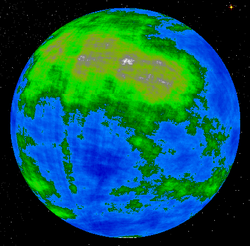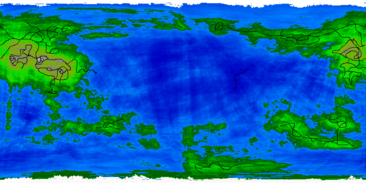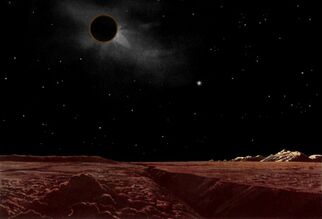Dawn
| Dawn | |
|---|---|
 | |
|
Location |
Helios System, Viperius Galaxy |
|
THI | |
|
Creator |
Styracosaurus Rider |
“This planet was a great surprise to us, because we didn't expect the immense diversity of the lifeforms here. They're almost like nothing else in Viperius. I suppose you could call it a second Kaventro, in a way...but Dawn is a true beginning in an new era of discovery.”
Dawn is a terrestrial planet located in the Viperius Galaxy. It is named for its moon, which rises each night like a second sun.
Planetary Characteristics
Location and Position
Dawn orbits the star Helios. It is approximately 0.9 AU from the star.
Rotation
Rotation is quick compared to some other planets of Dawn’s size, a day taking approximately 21 hours.
Composition
Dawn is composed primarily of iron and silicon, but there are higher amounts of sulfur than in other comparable planets.
Limestone is also a common rock in the crust.
Atmosphere
Dawn has a relatively high amount of O2 in its atmosphere; it is 30% oxygen. Most of the rest is nitrogen, with a small amount of trace elements.
Surface
The oceans take up around 72% of Dawn's surface, with the remaining portion taken by land. The surface is sometimes called the Overworld, in reference to the Caverns.
Satellites
Dawn has one moon, Anumati. Its high concentration of iron oxide on its surface gives the moon a reddish appearance. It is also much closer to the planet than in normal cases. The two factors make it look like a second sun rises at night, giving Dawn its name.
Anumati is slow-moving, and it has not shifted much in orbit since it was created.
Geography
Dawn has three major continents, in addition to a swathe of large and small islands.
Kulmis is the largest continent, three times the size of the next largest. It is a more varied land, with all the types of biomes. The other continents, Haols and Rai, are mostly forest.
From the positioning of the continents, an ocean is mostly enclosed by islands. This area is simply termed "The Deep".
The Caverns
Main article: The Caverns
The Caverns are a subterranean complex on Dawn. Hundreds of feet underground, there are systems of caverns and tunnels large enough to support a unique ecosystem. These systems range across the continental structures, and some small branches are known to trail under the deep ocean floor.
Some animals in the Caverns can reach lengths of 20 meters or more, such as the Virunga.
It is possible that animals were driven underground because of some effect of the Merge, although it is believed that the time necessary for this ecosystem to evolve to such an extent had to be much longer than 4 million years.
Life
Dawn is covered with amazing lifeforms.
Flora
Much of the flora on Dawn is markedly different from what might be found on other planets. However, some genera are still similar morphologically.
Fauna
There are several major groups of animals.
- Truncators are large animals that roam the plains.
- Kreigans consist of most of the bipedal animals.
- Yronans are mostly quadrupedal.
- Syreen are aquatic, and form the basis of the ocean food chain.
- Lairods are hexapodal and semi-hexapodal, and many are intelligent.
History
Dawn is an old planet, forming around 10 billion years ago. Cometary bombardment was a bit more severe than of most other planets, etching dramatic landscapes onto the planet's surface. At the same time, Dawn's moon was formed.
At some point after the oceans developed, underground floods are believed to have caused the formation of the Caverns.
Around 7 billion years ago, life on Dawn first formed. Interestingly, it is thought that it first developed in the dark and hostile water that existed in the Caverns instead of on the planet's surface.
In progress
Recent History
Dawn was discovered in the year 4.000(.005) AM by a joint team of scientists which included Salsenes, Atrenids, and Zyrothans. It caused quite a buzz, and scientists are currently conducting a vigorous study of the planet. The VWP is also scrambling in an attempt to catalog species.
Nutay Rinkam has likened the planet to "a second Kaventro," because of the diversity of lifeforms.



